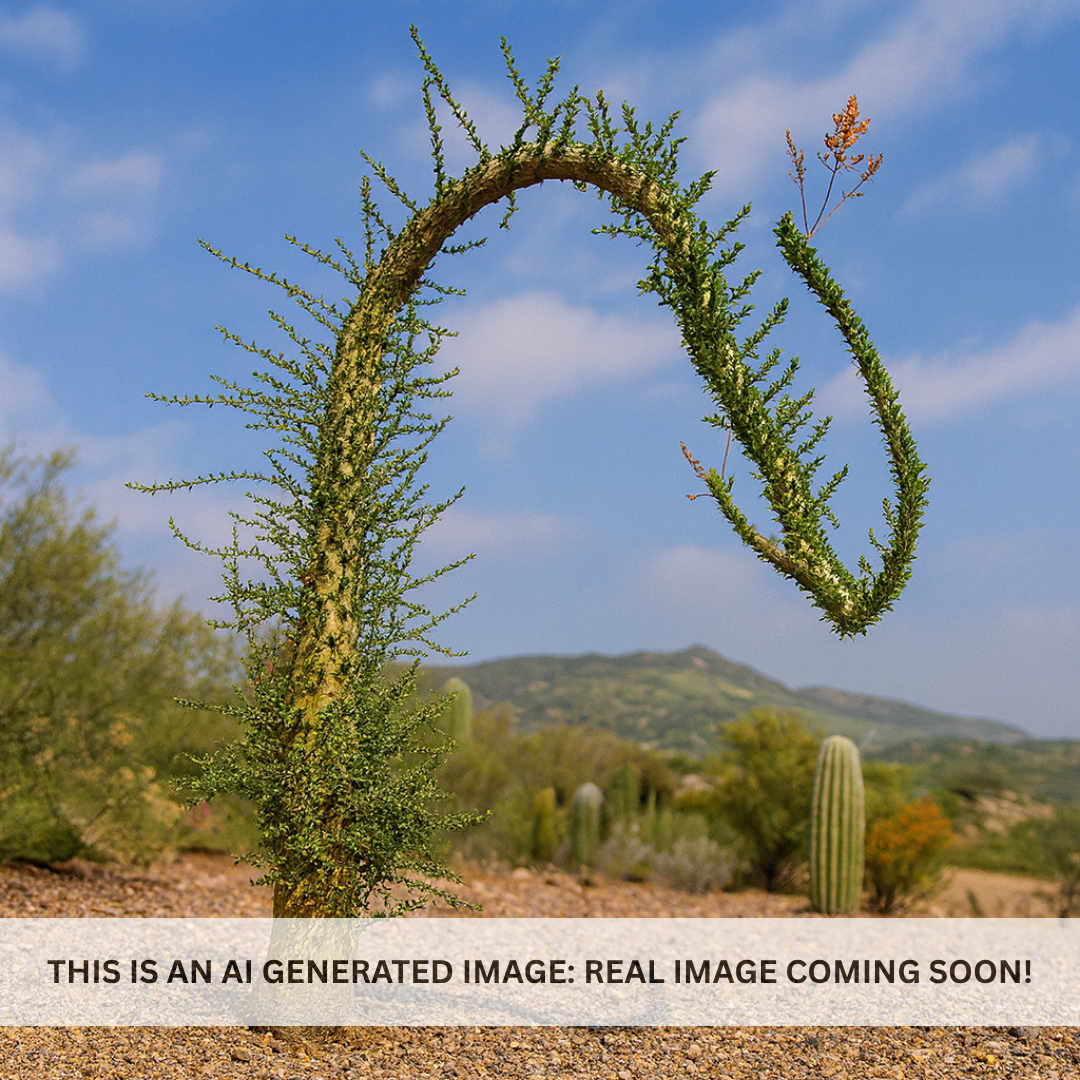My Store
Boojum Tree
Boojum Tree
Couldn't load pickup availability
Plant Type: perennial, succulent tree
Plant Height: 10–20 feet (can reach 50 feet in native habitat)
Spread: 6–10 feet
Flower Color: creamy white to pale yellow
Sun Exposure: Full sun
Boojum Tree / Fouquieria columnaris: The Surreal Desert Tree that Defines Baja’s Landscape
Fouquieria columnaris, known as the Boojum Tree, is one of the most unusual and captivating plants in the desert world. Native to Baja California and Sonora, this slow-growing succulent tree resembles something out of a Dr. Seuss illustration, with its tall, twisting trunk tapering toward the sky and small, whimsical side branches covered in tiny leaves and spines. In Arizona landscapes, it serves as a living sculpture—rare, dramatic, and unmistakably unique—bringing a sense of surreal artistry to desert designs.
Key Features of Fouquieria columnaris
The Boojum Tree features a thick, tapering trunk that may twist or lean as it grows, covered in small spines from which clusters of tiny, oval leaves emerge during the warm months. Unlike most trees, its trunk performs photosynthesis, allowing it to thrive in extreme aridity. During summer and fall, mature specimens produce clusters of creamy white or pale yellow tubular flowers that attract hummingbirds and native pollinators. As temperatures drop, the leaves are shed, leaving behind its distinctive bare, sculptural form. Boojum Trees grow slowly—often less than 6 inches per year—but develop extraordinary character and form over time, making each one completely unique.
Growing and Care Tips
Fouquieria columnaris thrives in full sun and sharply draining, sandy or rocky soil. It’s crucial to plant it in a location with excellent drainage—preferably on a slope or mound. Once established, it requires almost no supplemental water and should never be overwatered. During its establishment phase (which can take a year or more), provide deep but infrequent watering every few weeks, allowing the soil to dry completely between cycles. Overwatering can cause fatal root rot. The Boojum Tree is best suited for warm, frost-free microclimates; it tolerates brief drops to around 28°F but should be protected during hard freezes. When planting, handle carefully to avoid damaging the sensitive roots, and never remove its natural soil from the root ball.
Landscaping Uses
Few plants command attention like the Boojum Tree. Its whimsical, sculptural form makes it ideal as a centerpiece or focal point in high-end desert landscapes. It pairs beautifully with other architectural plants like Ocotillo, Blue Glow Agave, and Mexican Fencepost Cactus, as well as with large boulders or decomposed granite mounds that mimic its native Baja terrain. When silhouetted against a sunset or architectural wall, the Boojum becomes living art—an embodiment of the desert’s beauty and eccentricity.
Summary
The Boojum Tree is one of nature’s most extraordinary creations. With its spiraling, tapering trunk, minimal water needs, and decades-long lifespan, Fouquieria columnaris is both a conversation piece and a symbol of desert resilience. Ideal for collectors and landscape enthusiasts who appreciate rarity and sculptural design, it turns any Arizona garden into a work of art that evolves gracefully over time.
Three Timbers Installation Guide (Feel Free to Follow):
Fouquieria columnaris Planting Guide:
Location: Full sun; ideal placement provides maximum light exposure and warmth year-round. Choose a spot with excellent drainage and protection from prolonged frost.
Soil: Use a sandy, rocky, or decomposed granite mix with superior drainage. Do not plant in clay soils or areas that collect water.
Spacing: Allow 10–15 feet between plants or structures to highlight its full form as it matures.
Planting Depth: Keep the original soil line of the root ball level with or slightly above the surrounding grade. Do not disturb the root ball when planting.
Support: Young specimens may benefit from staking for the first year until the root system anchors firmly.
Watering Guide:
Watering After Planting: Water deeply once after installation to settle the soil, then allow it to dry completely before watering again. During the first 3–6 months, water every 2–3 weeks in warm weather, reducing frequency as the plant adjusts.
When is the Plant Established? Fouquieria columnaris is considered established after approximately 12–18 months, when new leaf growth appears consistently during warm seasons.
Watering Once Established: Water very sparingly—once every 4–6 weeks in hot, dry months and not at all during cooler seasons. Avoid any irrigation during periods of dormancy.
Drip Irrigation Setup: If using drip irrigation, install one low-flow emitter (0.5 gallon per hour) positioned 12–18 inches from the trunk. Run sparingly, allowing soil to fully dry between cycles. In many cases, no irrigation is needed once mature.
General Watering Tips: The Boojum Tree prefers neglect to attention. Overwatering is the fastest way to kill it. Always verify that the soil is completely dry before adding moisture. Surround the base with decorative rock or decomposed granite to reflect heat and enhance drainage, keeping the material several inches from the trunk to promote airflow and long-term health.
Share












